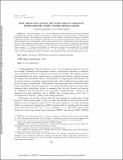Edit Distance Cannot Be Computed in Strongly Subquadratic Time (Unless SETH is False)
Author(s)
Backurs, Arturs; Indyk, Piotr
DownloadPublished version (328.3Kb)
Terms of use
Metadata
Show full item recordAbstract
© 2018 Society for Industrial and Applied Mathematics. The edit distance (a.k.a. the Levenshtein distance) between two strings is defined as the minimum number of insertions, deletions, or substitutions of symbols needed to transform one string into another. The problem of computing the edit distance between two strings is a classical computational task, with a well-known algorithm based on dynamic programming. Unfortunately, all known algorithms for this problem run in nearly quadratic time. In this paper we provide evidence that the near-quadratic running time bounds known for the problem of computing edit distance might be tight. Specifically, we show that if the edit distance can be computed in time O(n2−δ) for some constant δ > 0, then the satisfiability of conjunctive normal form formulas with N variables and M clauses can be solved in time MO(1)2(1−)N for a constant > 0. The latter result would violate the strong exponential time hypothesis, which postulates that such algorithms do not exist.
Date issued
2018-01Department
Massachusetts Institute of Technology. Computer Science and Artificial Intelligence Laboratory; Massachusetts Institute of Technology. Department of Electrical Engineering and Computer SciencePublisher
Society for Industrial & Applied Mathematics (SIAM)
Citation
Backurs, Arturs and Indyk, Piotr. 2018. "Edit Distance Cannot Be Computed in Strongly Subquadratic Time (Unless SETH is False)." 47 (3).
Version: Final published version
ISSN
0097-5397
1095-7111
Keywords
General Mathematics, General Computer Science